Though Hebe the mural was only born a month ago through Jenny Ustick’s creative genius as part of Walls for Women, the story of Hebe the statue in McMinnville dates back more than a century, long before any of us were alive. But before I get into the backstory of how Hebe came to live in Warren County, it’s important to outline just exactly how this project came to be.
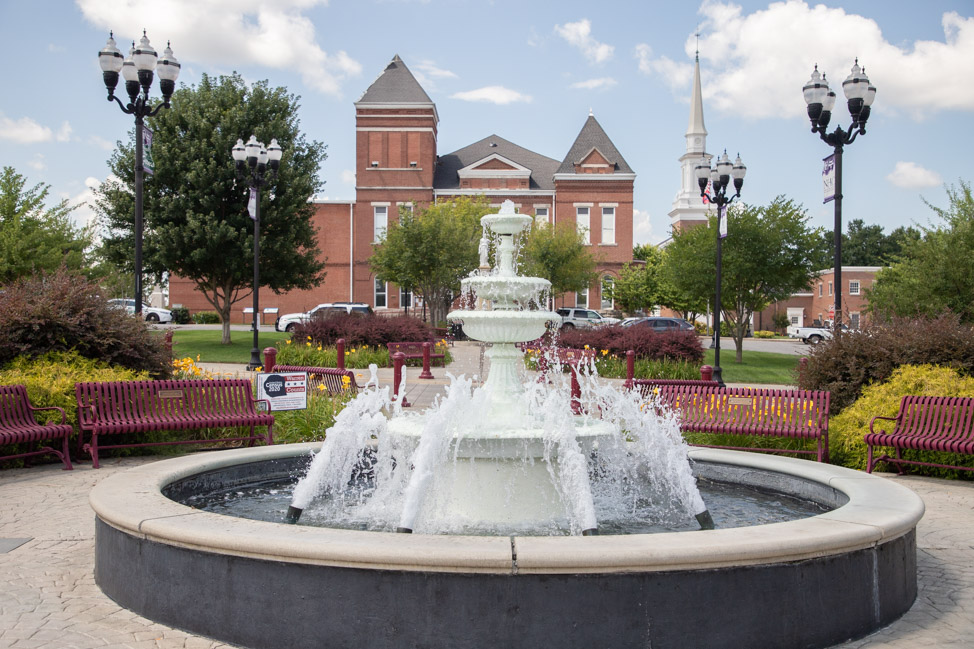
Working with McMinnville’s tourism board
The city of McMinnville is one of the best examples of smart rural tourism in Tennessee, as well as how to create a master plan and stick with it over decades as your city grows and blossoms. The Main Street is positively gorgeous, and I wish all small towns in Middle Tennessee took pride in maintaining and fixing up their buildings the way McMinnville residents and businesses have.
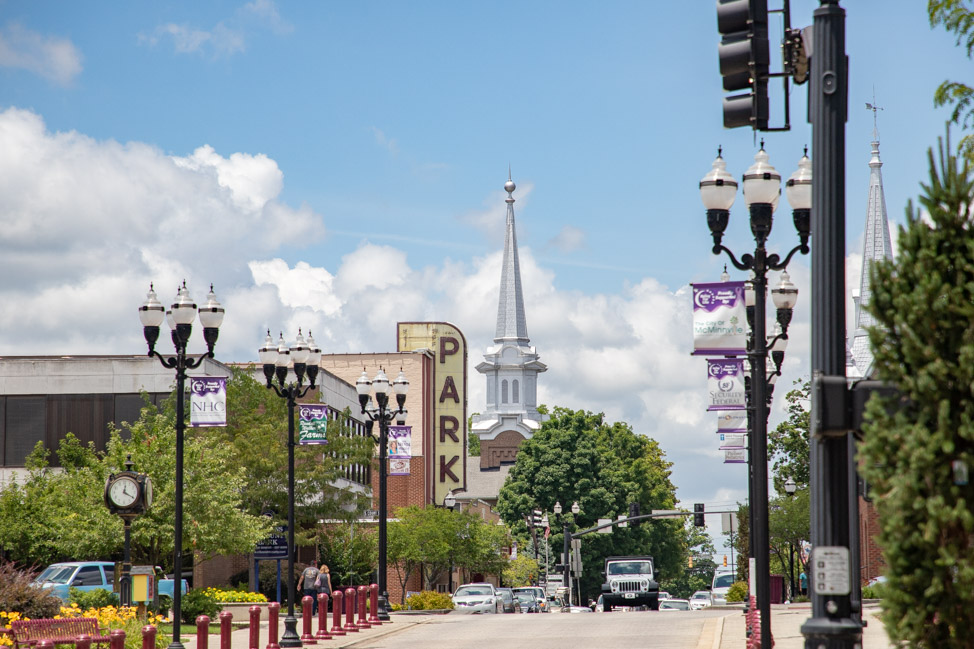
The Tourism Development Board, an entity of the City of McMinnville that is currently administered by the Chamber of Commerce, was one of the first partners to sign on for Walls for Women when we put out a call last winter for any city who wanted a mural. I loved everything about working with McMinnville and learning what a prosperous town it has become thanks to the vision and follow-through of a group of devoted citizens, many of whom we met and befriended through this project.
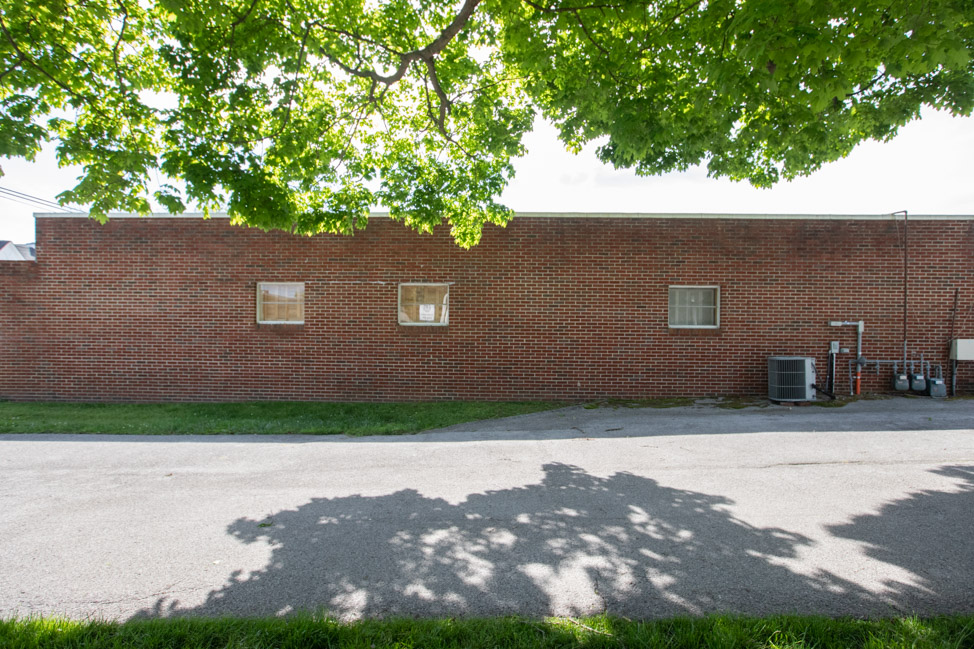
One of the board members is also executive vice president of Security Federal Savings Bank, and it was his idea for us to use one of the brick walls on the bank grounds for Walls for Women. Securing a wall is usually the trickiest part of any mural project, so Michael Griffith made that process easy-breezy for us. He’d also taken it upon himself in years’ past to commission a postcard mural, so one of the bank walls already donned a piece of art, and he connected us to an awesome local, Steve Harvey, who donated the scaffolding for the artists to use. Honestly, if every mural project were as seamless as working with McMinnville’s team, then I would quit my day job as a journalist and tourism marketer and only do public art.
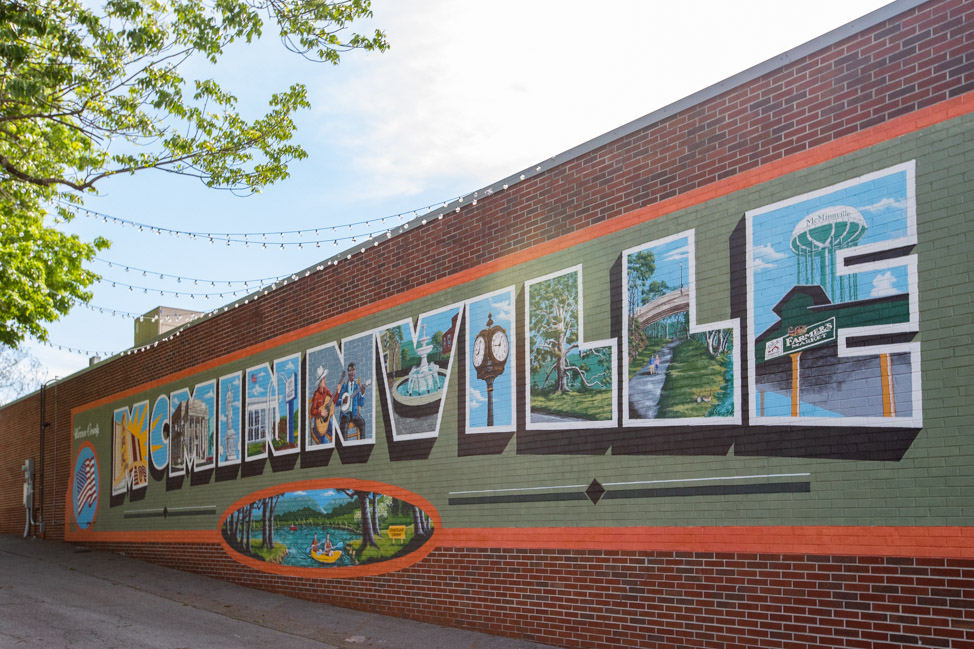
On top of all that, the Security Federal Savings Bank lawn is also the site of Main Street Live!, a free music concert series every Friday night throughout the summer. Perfect backdrop for a mural, no?
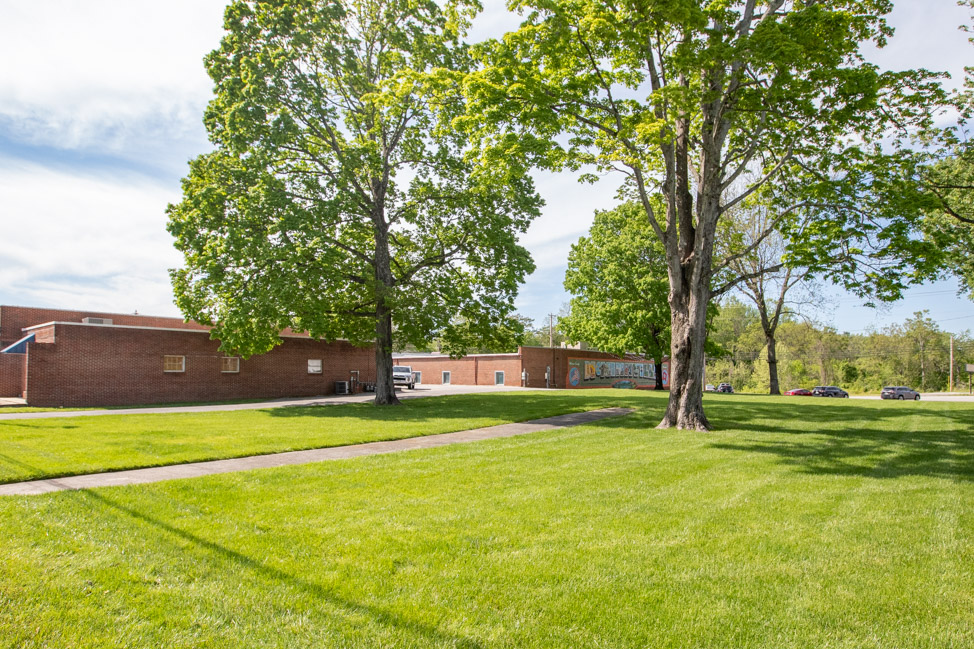
The history of Hebe in Warren County
If you’re a fan of Greek mythology, you’ll recall that Hebe is the goddess of youth who proffers the cup of immortality at the table of the gods. Beyond that, however, I knew nothing about Hebe’s presence in McMinnville until Jenny shared her mural rendering earlier this summer; shortly after, I met the incomparable Rachel Killebrew, a McMinnville native who worked with Wernher von Braun on the Apollo 11 program—yes, she’s a total bad ass!—and eventually left Kennedy Space Center, making a few stops in towns like Kansas City before returning to her Tennessee roots in the 80’s.
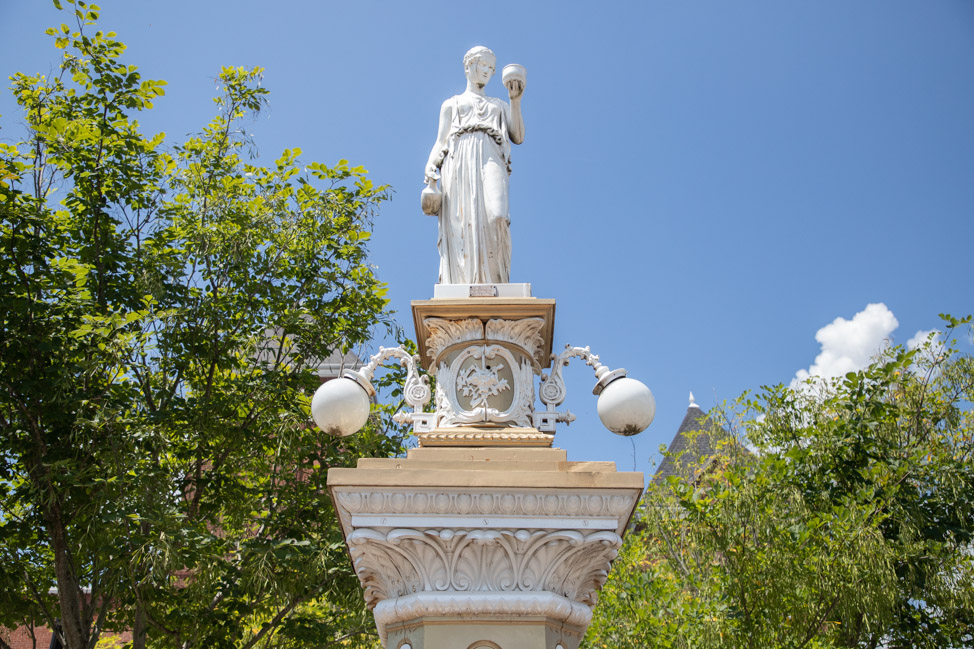
As we lunched with Rachel, Warren County’s tourism director and WFW project lead Mandy Eller and former McMinnville Main Street director Amy Jo Stanford, we learned all about this statue that preceded every one of us. Back in 1914, a cast iron drinking fountain was built and donated to the city of McMinnville by Laura Davis Worley and her sister Florence Davis, as a memorial to their parents, Captain O.W. Davis and Elizabeth. The three-level fountain officials was created to accommodate horses, people and other small animals (remember: this was an era before automobiles!).
Like many women, Hebe started feeling the effects of time and, eventually, was on her last leg, so in 1999, the Heritage Alliance, Main Street McMinnville and the Leadership McMinnville starting fundraising to save the city’s First Lady.
Because I didn’t want to mince words or not properly credit anyone involved with the restoration, I asked Rachel, who was heavily involved in the efforts, to send me a summary of exactly how it went down. Here’s what she wrote:
Hebe stood in the City Park from 1915 until a restoration effort was begun. When Main Street McMinnville was formed in early 1990s to begin a master plan to renovate downtown McMinnville, a group formed to begin to assess the damage to the statue over the last 75 years. We began a search for metallurgical engineer to assess the damage. The base of the status is made of cast iron and the statue itself is made of pot metal; both are hollow inside and were rusting from the inside out.
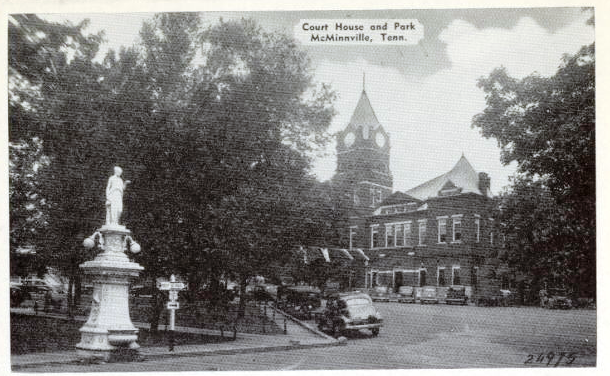
There are two fountains: one lower one for animals such as pigs that had been brought to the park to be sold at market place and a taller fountain for the horses and cows that wanted to drink from the fountain. In the winter, those fountains would freeze and further caused problems for the hollow statue and base.
The committee was meeting one night in the early 1990s when a gentleman came in, sat down quietly and listened to our assessment and our plea to once again return the statue to “good health” and rededicate the statue at the reopening of the Park after the Main Street McMinnville Phase I restoration. He introduced himself and told us that he was a metallurgical engineer who had moved a metal stamping business to McMinnville recently and heard our message. He said he would work on the statue every night after work and restore it if we would only buy the materials that he needed and he would donate his labor. He went to work and not a minute too soon.
The electric company used their trucks to help and Mr. McGaw developed a bra-net to hold the statue. The minute the net was placed around the statue, we heard a loud snap and the statue fell in the bra-net. She was so ready to fall and, to the amazement of those watching, she only snapped loose when the net caught her.
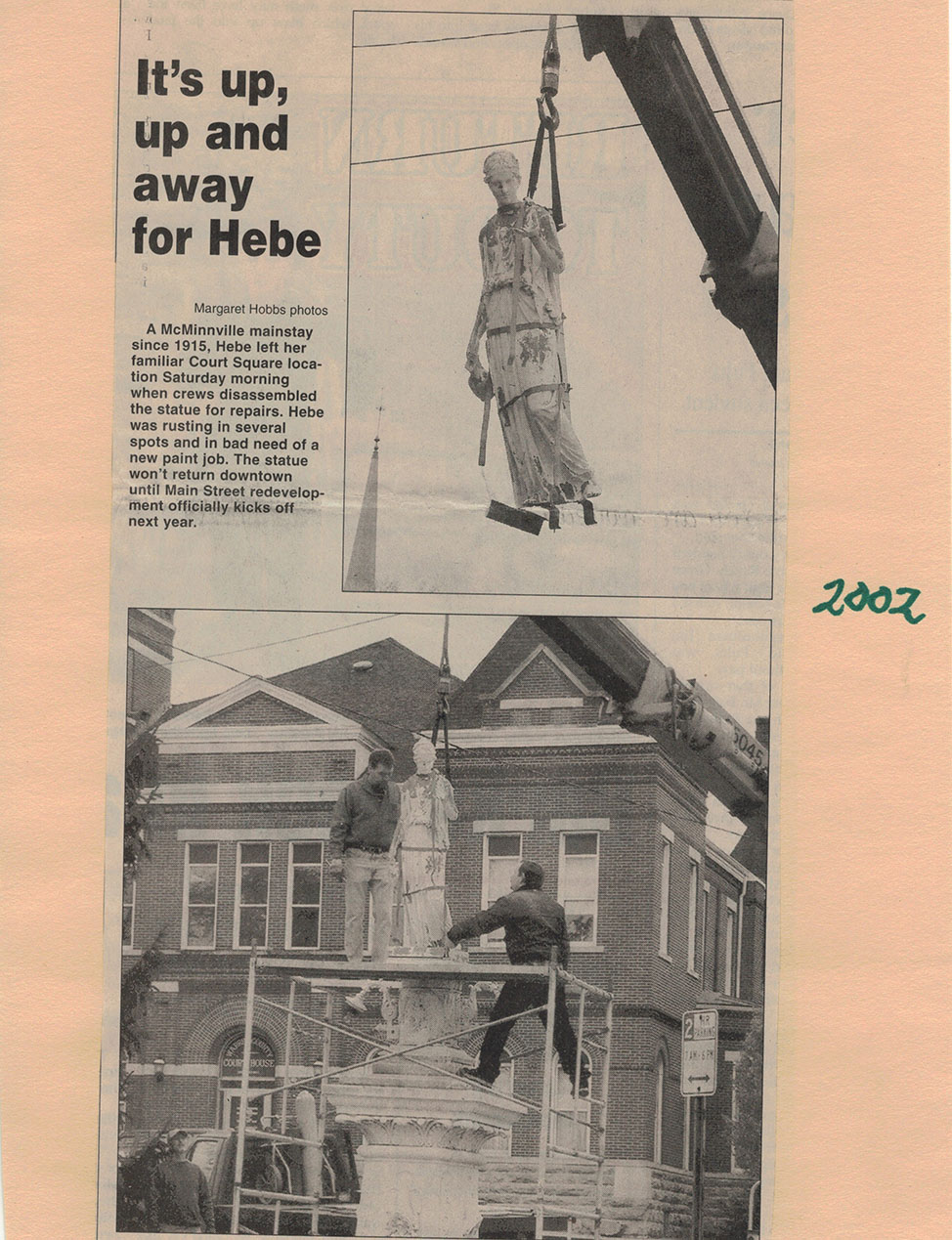
Mr. McGaw had her moved to his factory where she was dismantled into 58 pieces, which he put on stands that allowed him to work in the hollow insides for the first year since the statue was so fragile. He then filled the inside to gain strength for the statue so that the outside could be renovated. Every night, Mr. McGaw worked that first year to strengthen the statue from the inside out so that he could begin the work on the outside without fear that she would cave in.
The work then started, and it took another year and a half of nightly work, all by a careful hand that had the education and experience to perform this delicate work. Our committee went over often to thank him for this dedication of work to save our lady in the middle of our town. We had already started planning the reopening of the downtown Main Street when we got a call from the landlord of the rental apt where Mr. McGaw was living and he gave the bad news that Mr. McGaw had cancer and he had very few days left to live. He had never told us this, and his son was already on the way from Cincinnati to take his father to a hospital in their hometown.
We hurriedly took over his awards and commemorations for his amazing devotion to the job he took on in a town that was not his own. We had planned to honor him at the opening rededication of Hebe in good health once again to watch over our City. Mr McGaw died soon after this meeting and was not at our dedication of Hebe and our Downtown revitalization, but he will never be forgotten to his amazing dedication to getting the job complete.
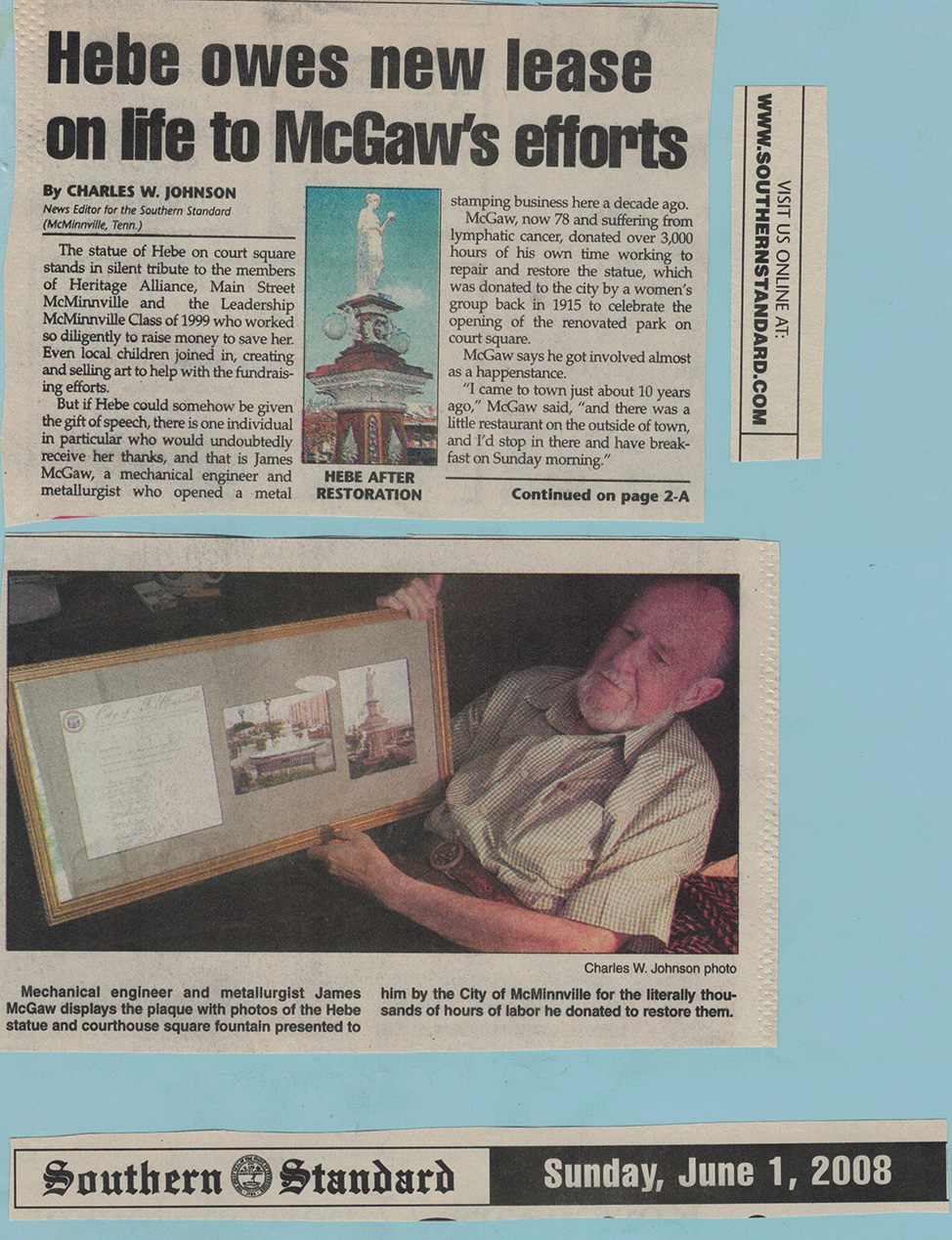
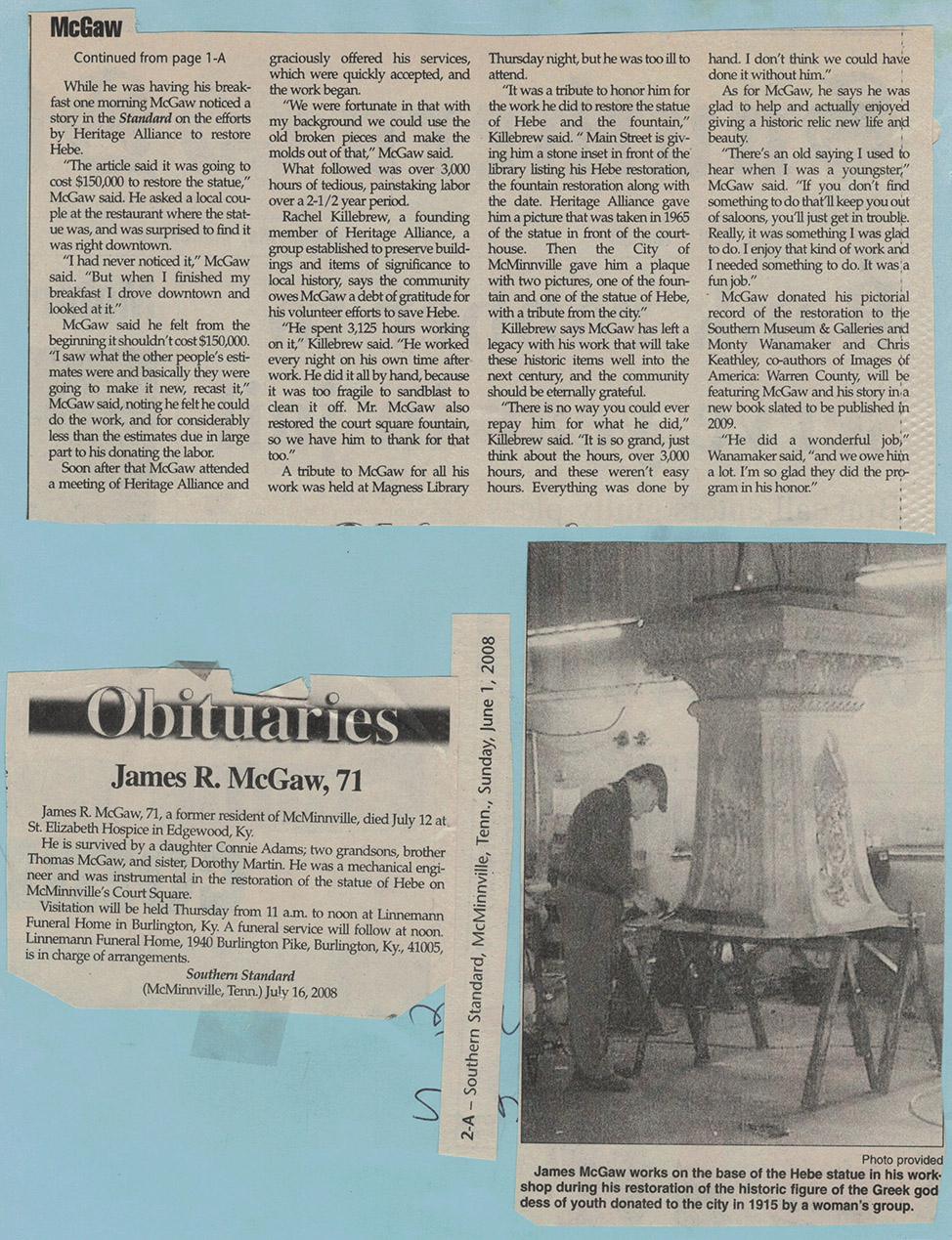
At the base of the statue, there are four stones engraved that will hopefully keep this man from ever being forgotten for what he did for our city.
How we met muralist Jenny Ustick
Our friendship with Jenny Ustick is a product of our travels. Eighteen months ago, we landed in Cincinnati for the first time, immediately blown away by the creative placemaking ingenuity in the Ohio city and also by the large presence murals have throughout the downtown core.
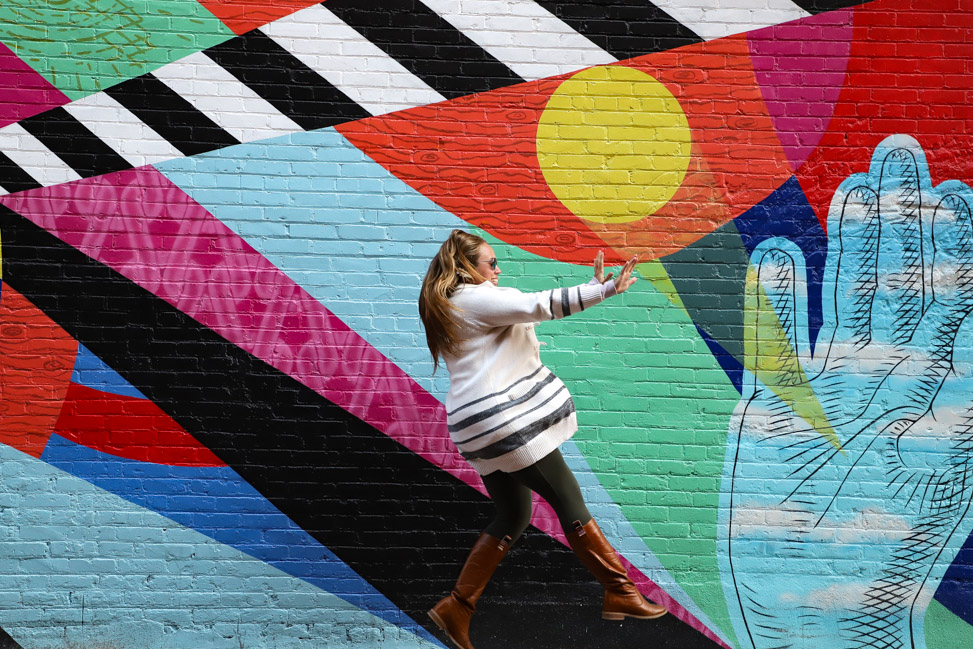
The above mural lives on the side of the 21c Hotel Cincinnati, where we have stayed on each visit, and was our introduction to the colorful, magical world of Cincy art. It’s also how we came to follow Jenny, as she’s the creator of this piece, as well as dozens of other iconic murals in the area.
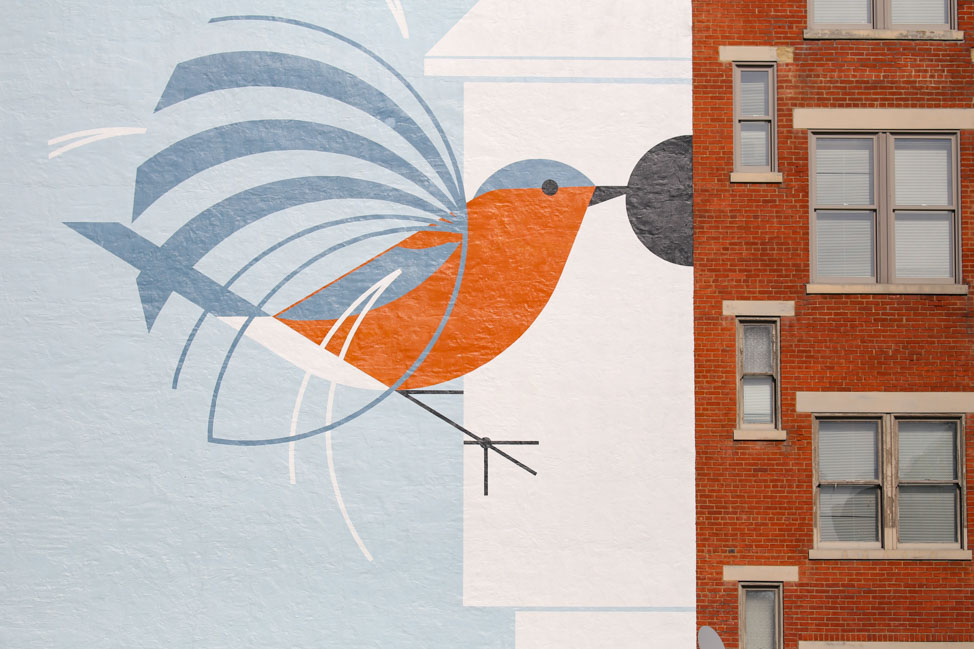
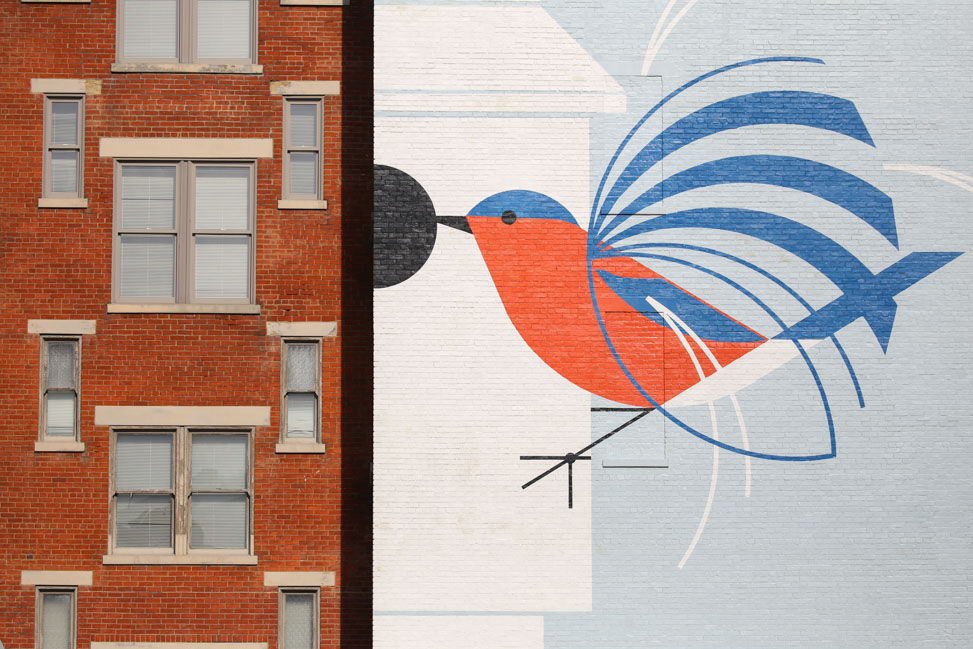
And then we finally met Jenny in person at BLINK last October—I may have had a total fangirl moment—and she was as lovely and down to Earth as I knew she’d be. I casually mentioned we wanted to bring her up to Tennessee, I just wasn’t sure when and for what project. Then Walls for Women came along.
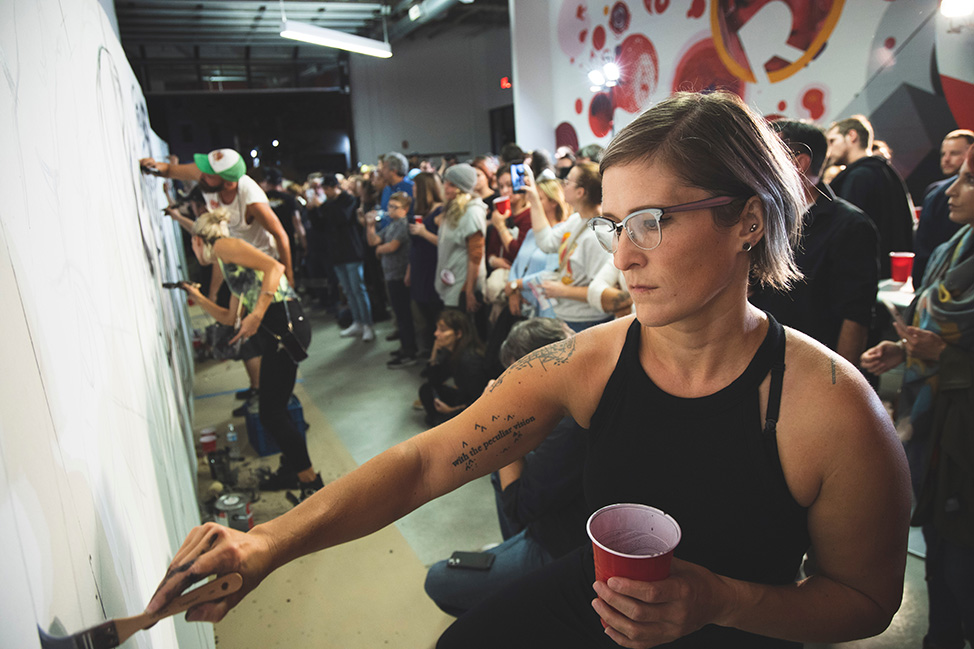
I knew without a doubt that Jenny would be one of our top picks for a Walls for Women muralist were she available. The only thing is that she’s an academic who teaches art at the University of Cincinnati—meaning her schedule is already full as it is—plus a very sought after artist. Luckily, we got on her radar in enough advance time for her to block out 10 days to come down to Tennessee in July.
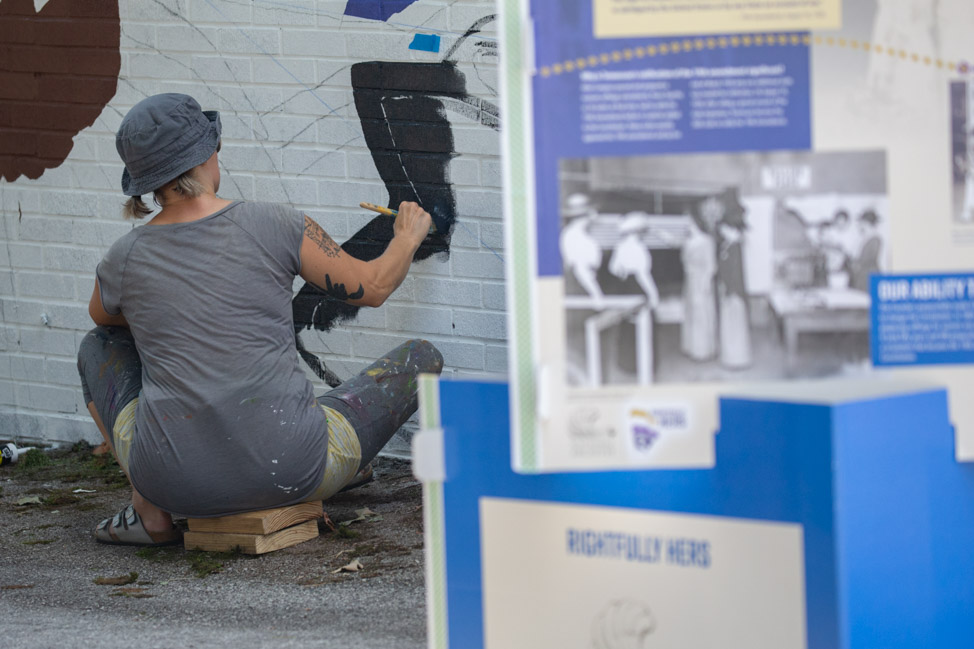
Jenny and crew arrive in Tennessee
What we didn’t know is that she’d wind up bringing three artists to assist her with this massive wall. Three additional artists—Atalie Gagnet, Rachel Linnemann, Aubrey Theobald—means we now have three more friends in the art world, each of whom brought her own skill set to the table.
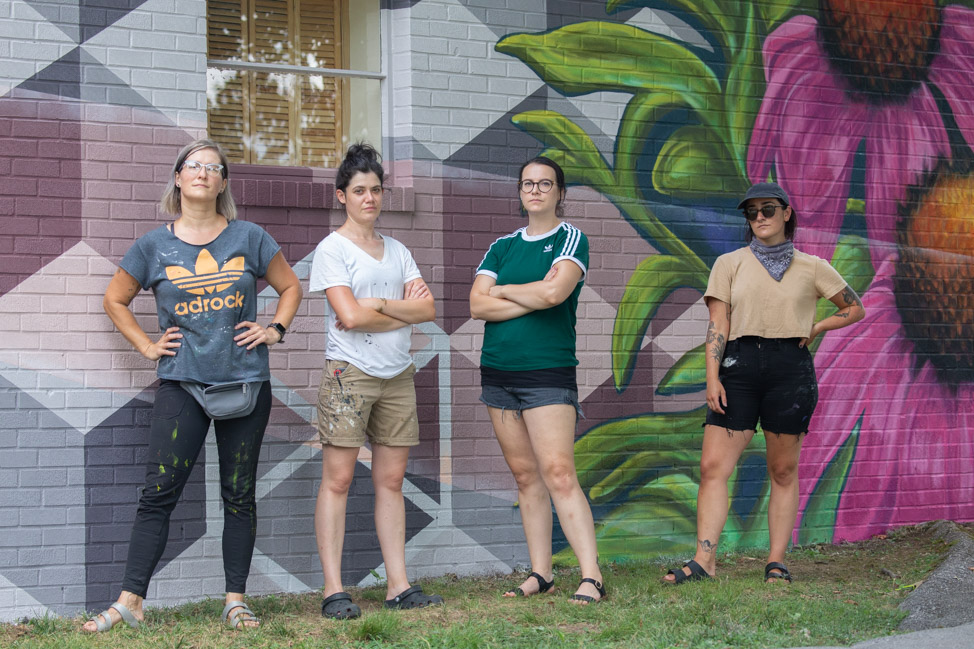
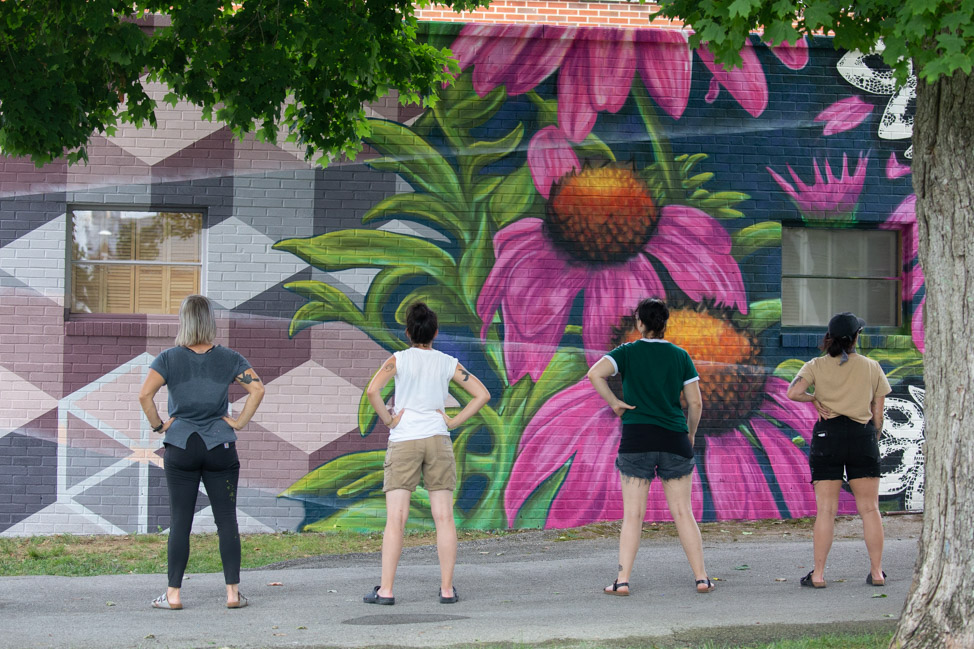
The weekend before they arrived, SVV and I went to McMinnville and buffed out the wall. The building was raw brick, so we did a base coat with a paint specially formulated for raw brick with the sprayer and a roller, then came back the next day to add a top coat. Then, the wall was ready to go for them.
They projected the design the first night in town so they had a rough outline with which to work, then the next day starting meticulously filling her in.
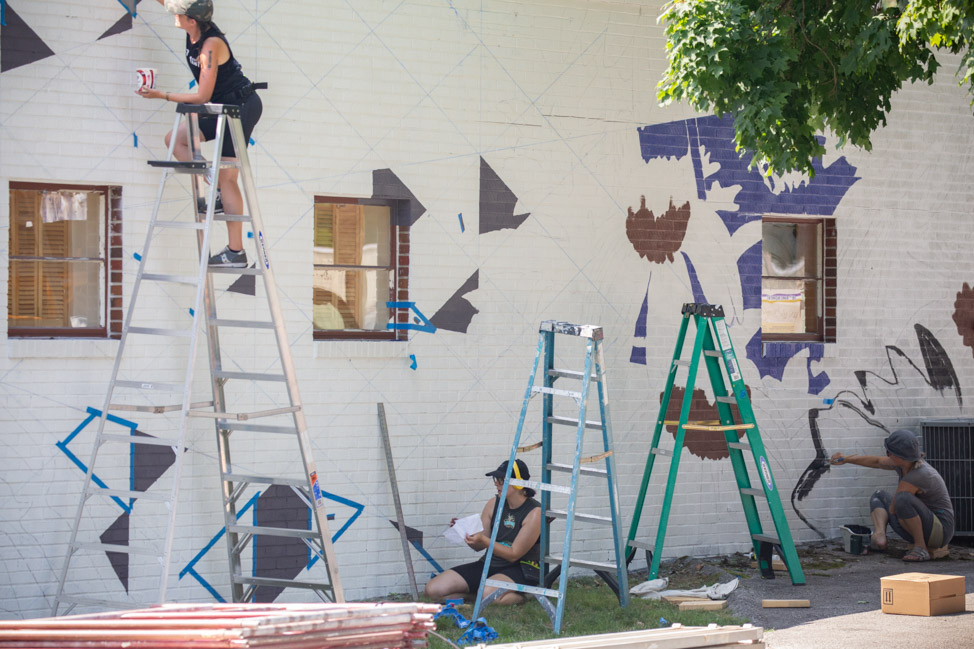
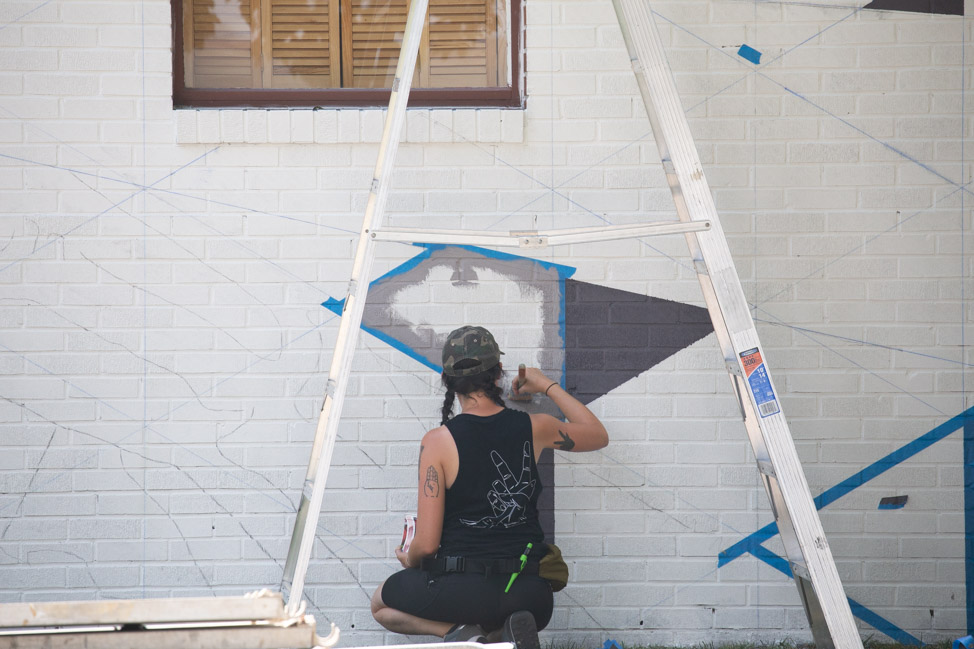
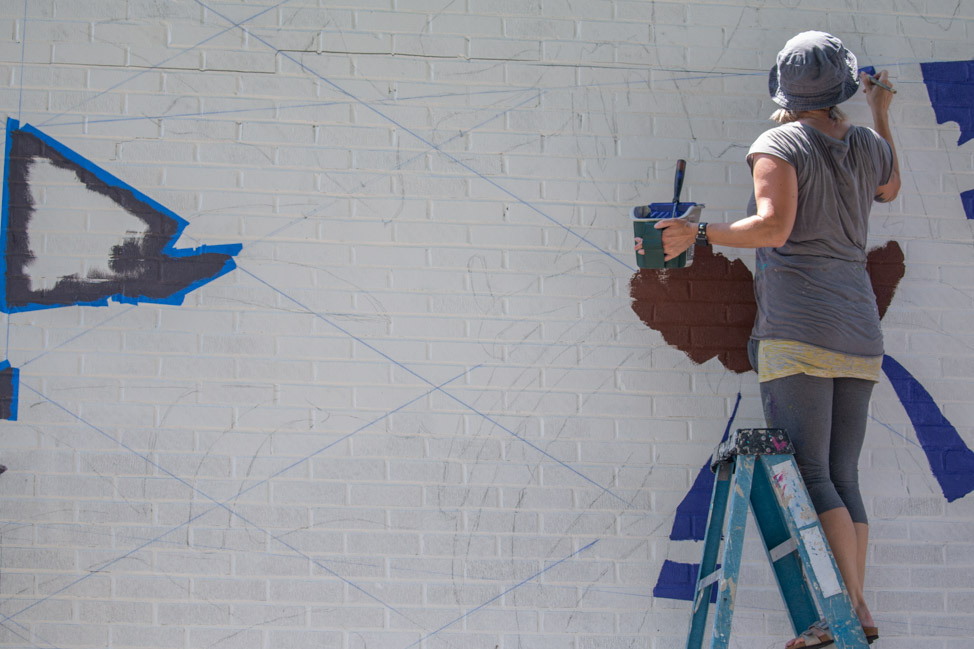
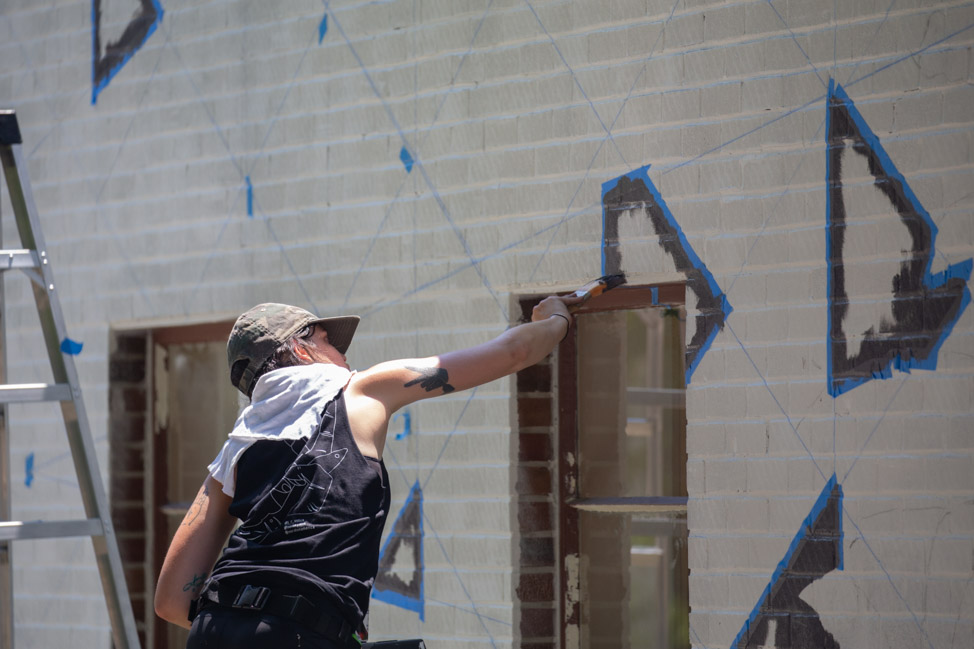
The Hebe mural comes to life
As an academic, it’s no big surprise that Jenny dug deep into the area’s history. I get so annoyed by the many requests we get from other towns (not McMinnville) for “a mural of historical significance” because they ultimately mean buildings on buildings or wagon wheels or other imagery from a bygone era, when in reality artists often incorporate a sense of place with a much deeper meaning, like Jenny did.
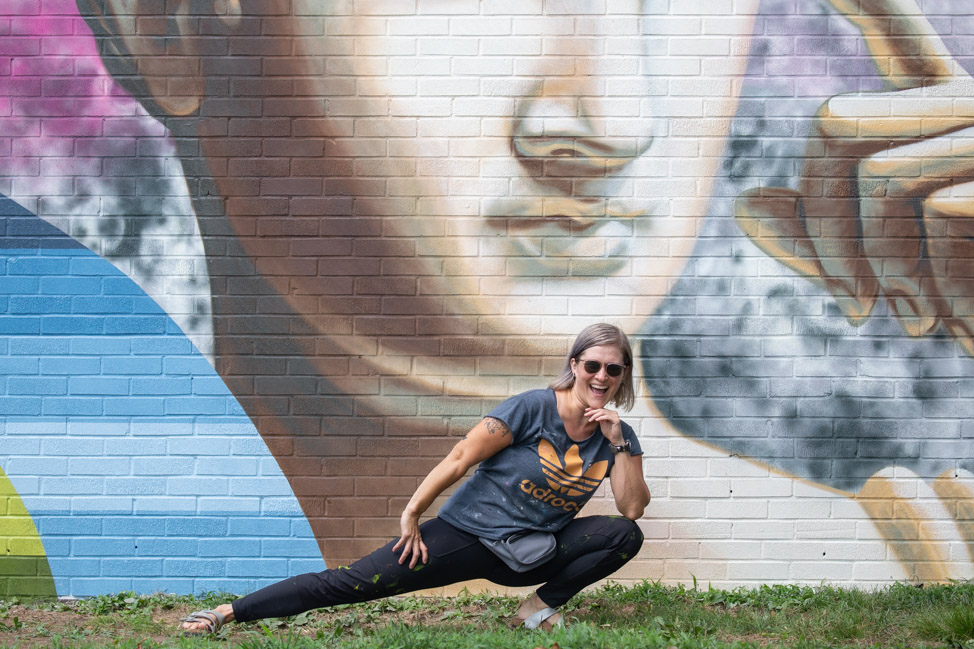
Before she arrived in McMinnville, she spent weeks researching the town’s history and went deep down a rabbit hole about Hebe. The final concept—which took the women nine days to complete with a mixture of bucket paint, brushes and rattle cans—is a product of artistic genius. In Jenny’s words, here’s the full meaning of downtown McMinnville’s new “Hebe, the Moon, the Rivers and the Land” mural:
“I was invited to paint in McMinnville, so I set to work researching scrappy women in the city’s history. My design is four murals in one, with a breadth of style reflective of the beauty of collaboration and diversity of thought. The beloved statue of Hebe, goddess of youth and renewal, is emblematic of a collaboration between Mary Cunningham and Laura Davis Worley, who conspired to make life better for their hometown. Behind Hebe are the moon, the earth, and the waters of the Barren Fork and Collins rivers.
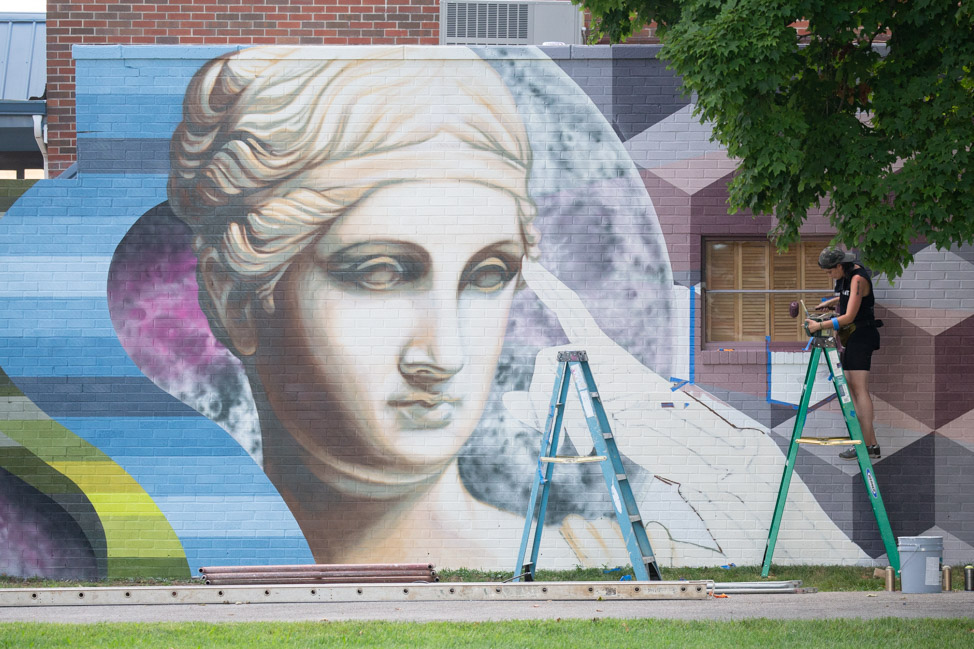
“A hand touches Hebe’s forehead as she projects her healing youthful strength across time and space. The hand is derived from an etching of Frances Wright, outspoken suffragist from the 1800’s. To the right of Hebe are crystalline forms derived from the saltpeter that was mined in the nearby caverns. I’m interested in the duality of it: used as an ingredient of gunpowder that fired guns in the civil war, saltpeter was also an essential ingredient of fertilizer that helped build the massive horticulture industry in the region; death and life, depending on how it is used.
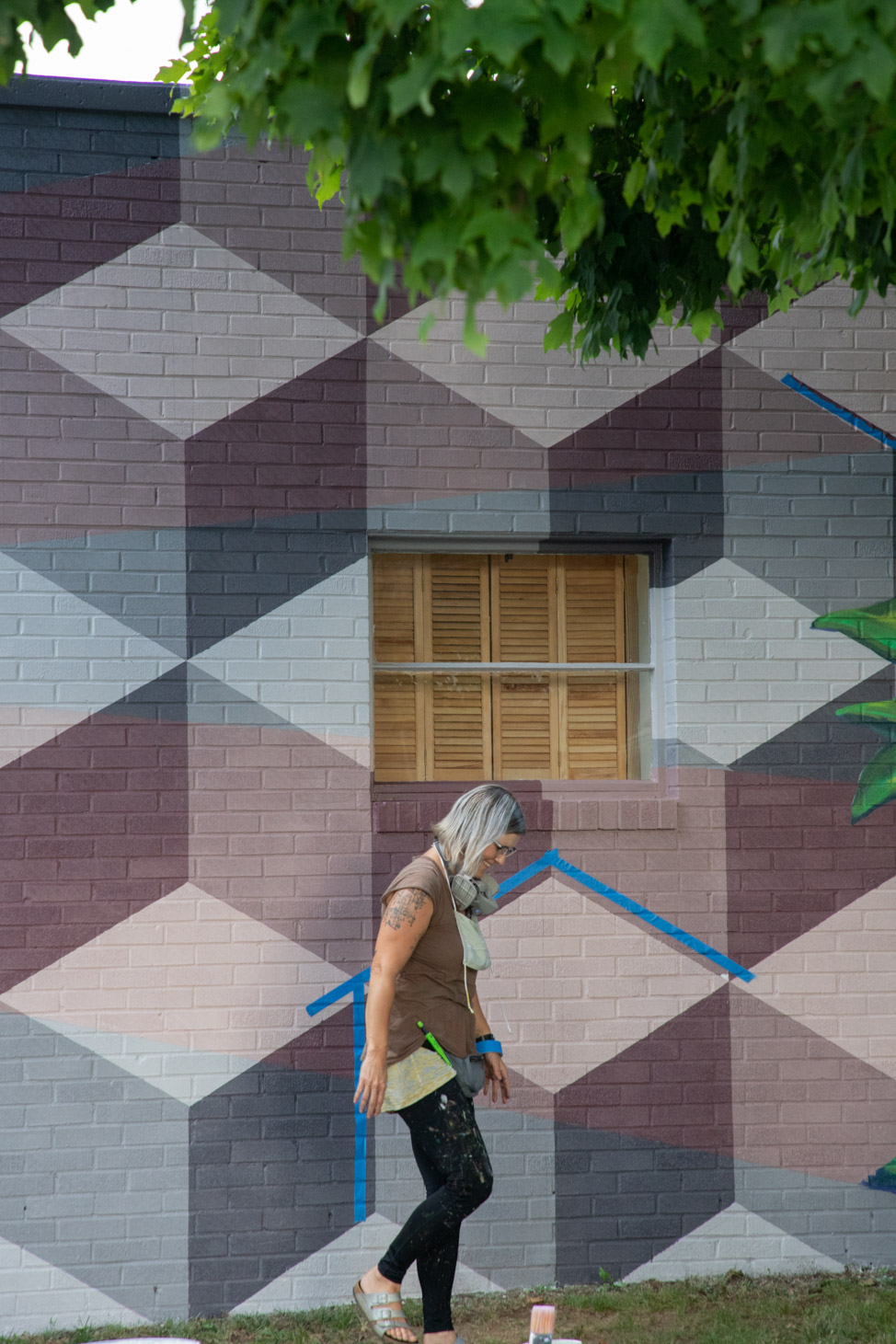
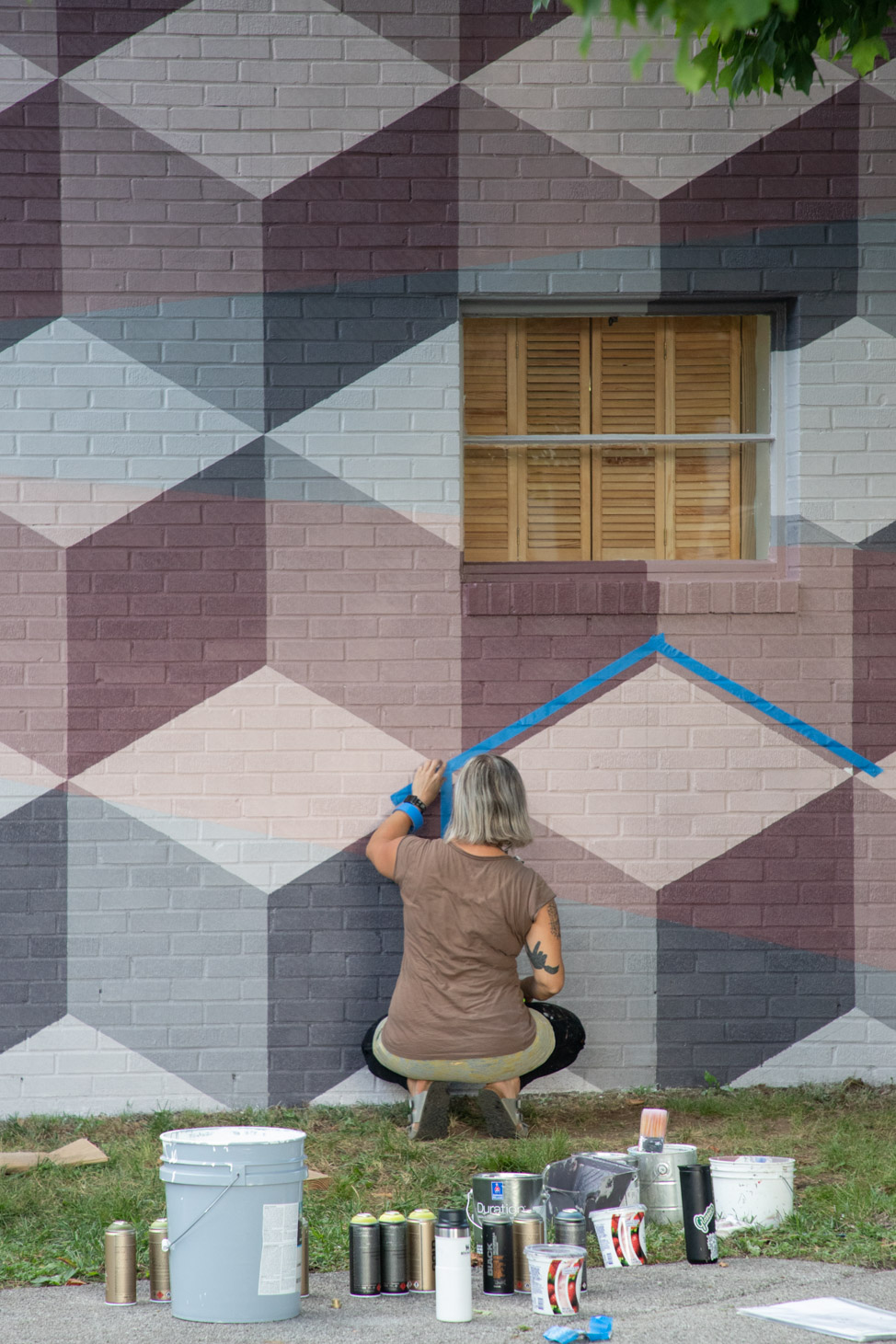
“To the right of the crystal field are Tennessee purple coneflowers (aka echinacea), prized by the indigenous tribes (mainly Yuchi and Cherokee) that once populated the region, but also representative of the nurseries that make McMinnville the Nursery Capital of the World.
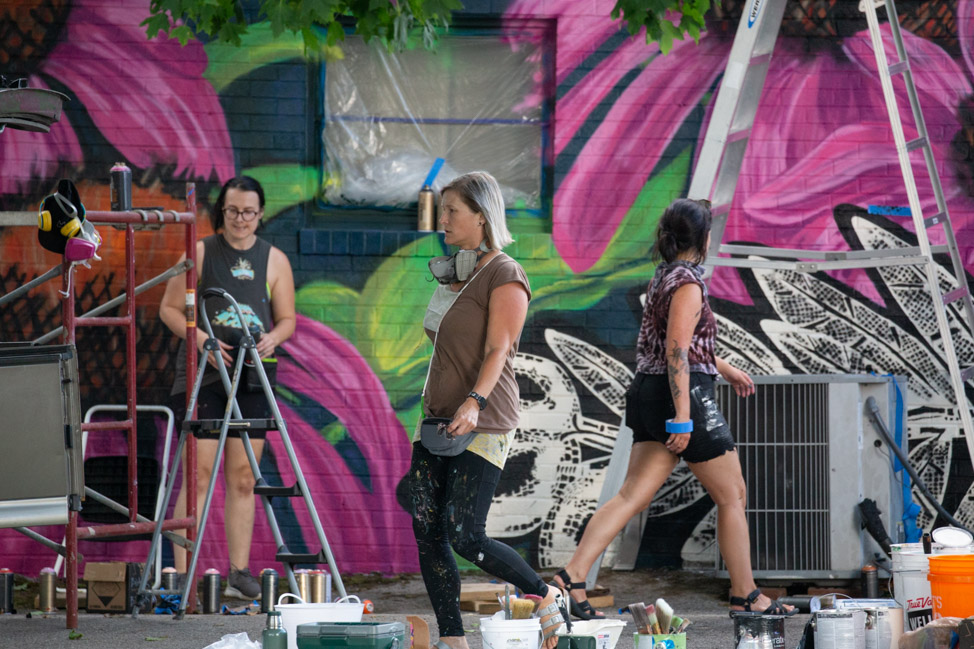
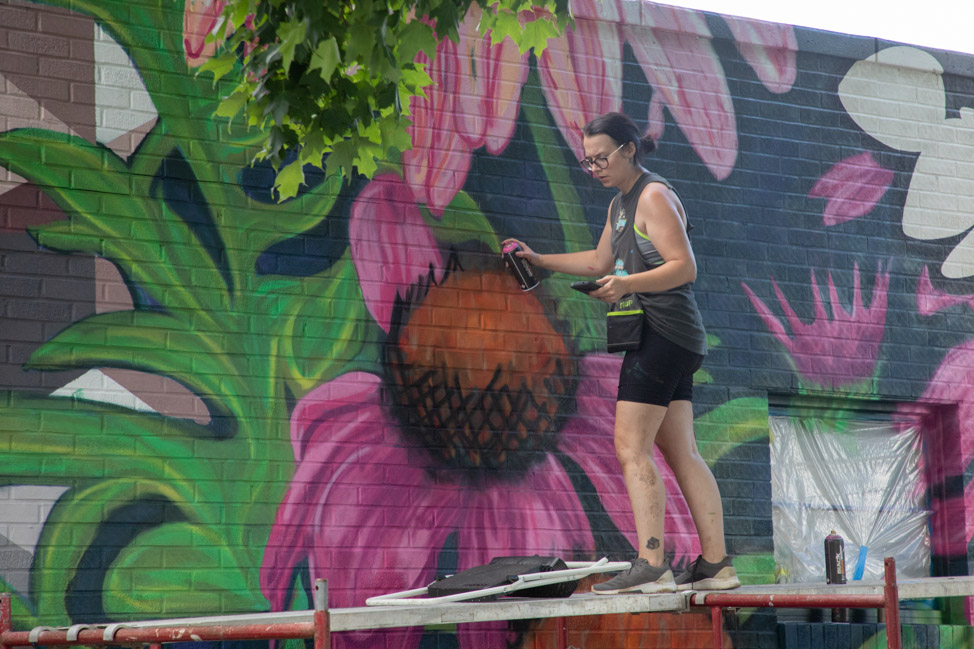
“Finally, on the right is an inverted illustration—white against a black background—of pecan leaves and drupes. This bookends the mural with multifaceted contributions to the history and industry of the city in which women played an important role. Judith Turner Harrison, who lived in the city’s famous Black House, collected rare plants and helped introduce horticulture to the area. She is credited with bringing the first cultivated pecan trees to the city. A slave in Louisiana known only as Antoine, who was an expert horticulturalist, developed a way to propagate individual pecan trees, making this transplantation possible.”
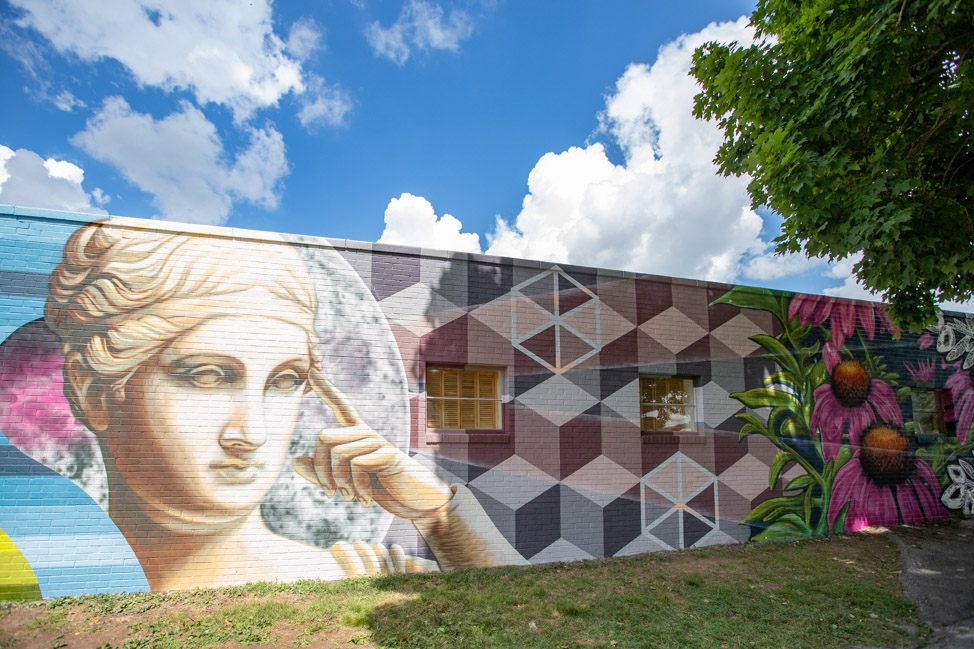
This mural is so layered, so nuanced and was created with such heart. Thank you, Jenny and team, for leaving a piece of your soul behind in McMinnville! “Hebe, the Moon, the Rivers and the Land” was completed on July 29, 2020. I think she’s the perfect tribute to the women who first commissioned the statue a century ago, to Mr. McGaw who spent his final years restoring her to her former glory and to the community of McMinnville who could not have been more welcoming of this quartet of talent.
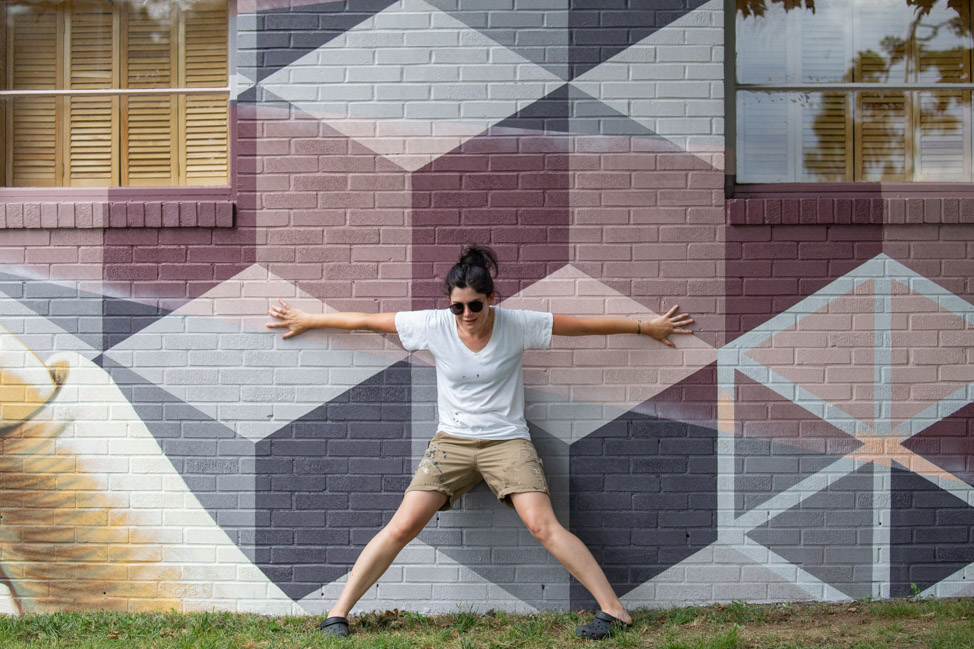
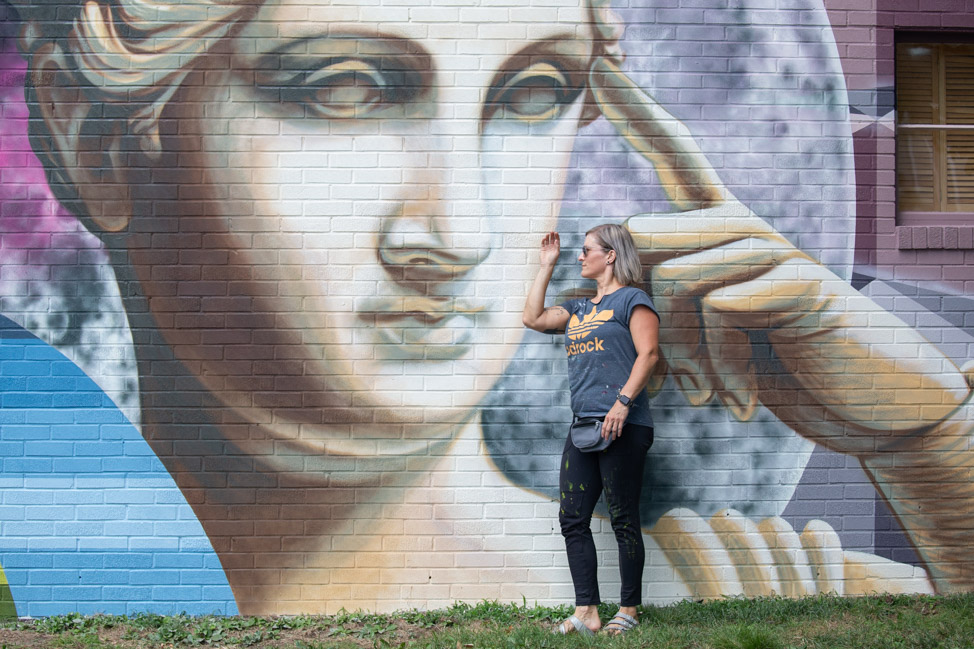
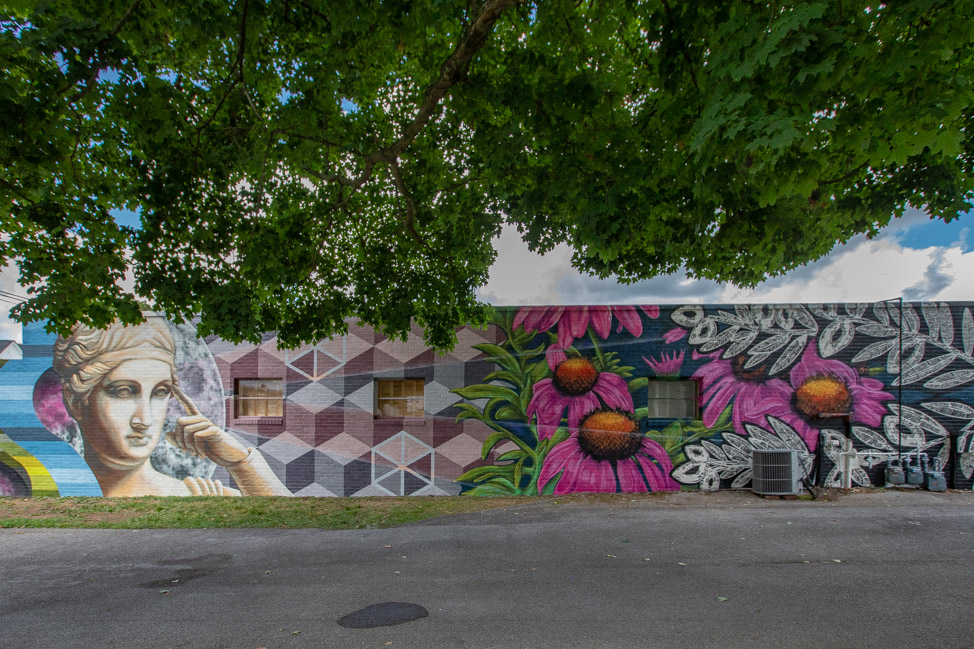
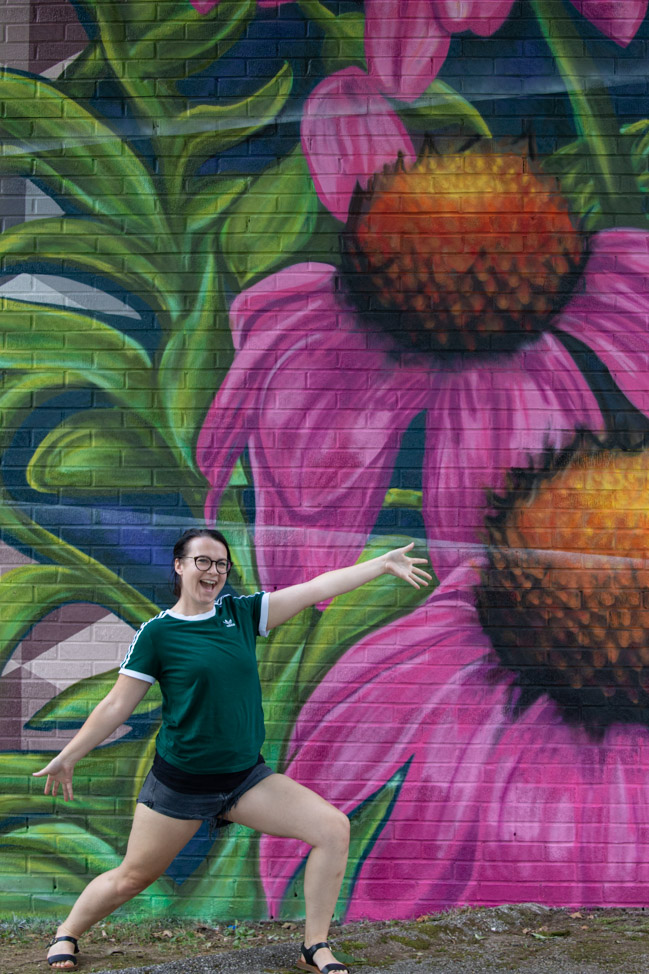
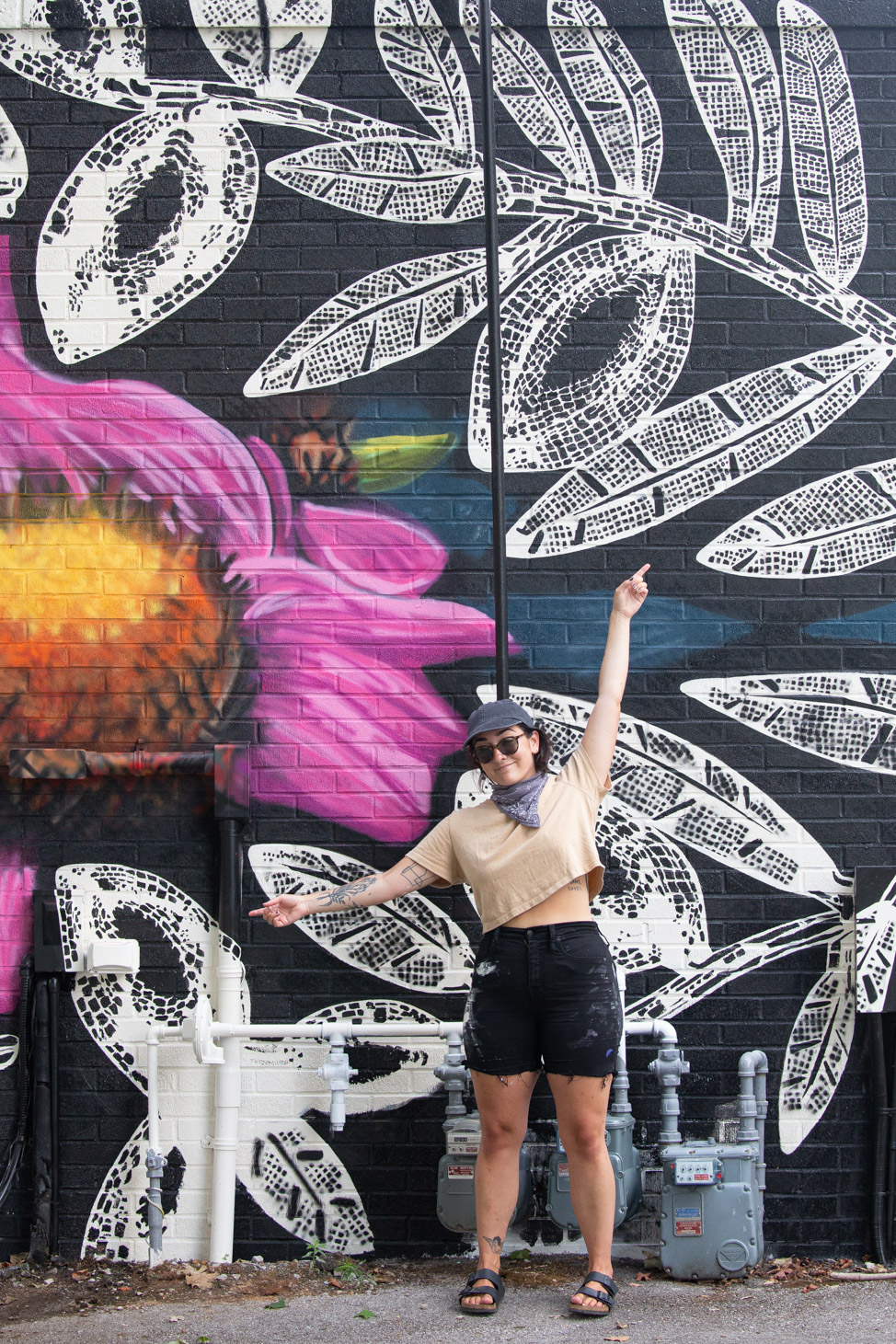
Where you can find Walls for Women murals
Here’s a handy map to guide you around all of DMA’s murals throughout Tennessee:
For more public art resources, start here:
- How to start a mural program
- Why it’s important you allow artists creative freedom
- Fact or fiction: debunking myths about murals
- Using murals in marketing: are you violating somebody’s copyright?
- How a mural gets made: The story of “Wisteria Maide” in Tullahoma
PIN IT! SAVE THIS POST FOR LATER
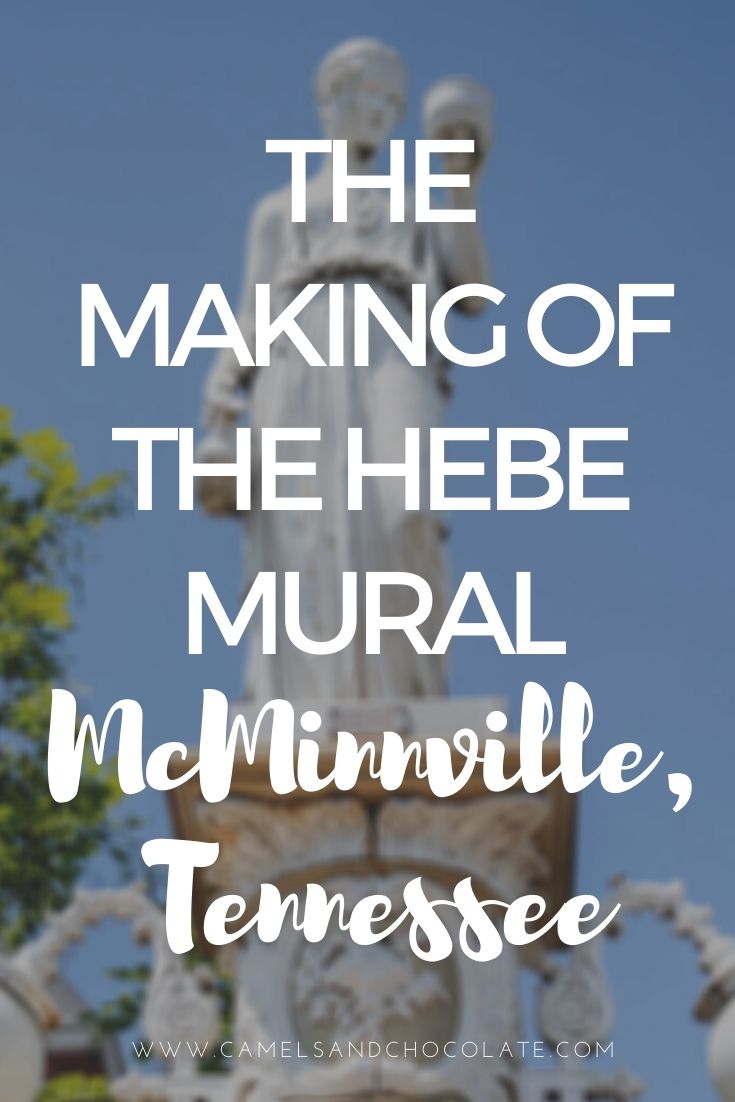
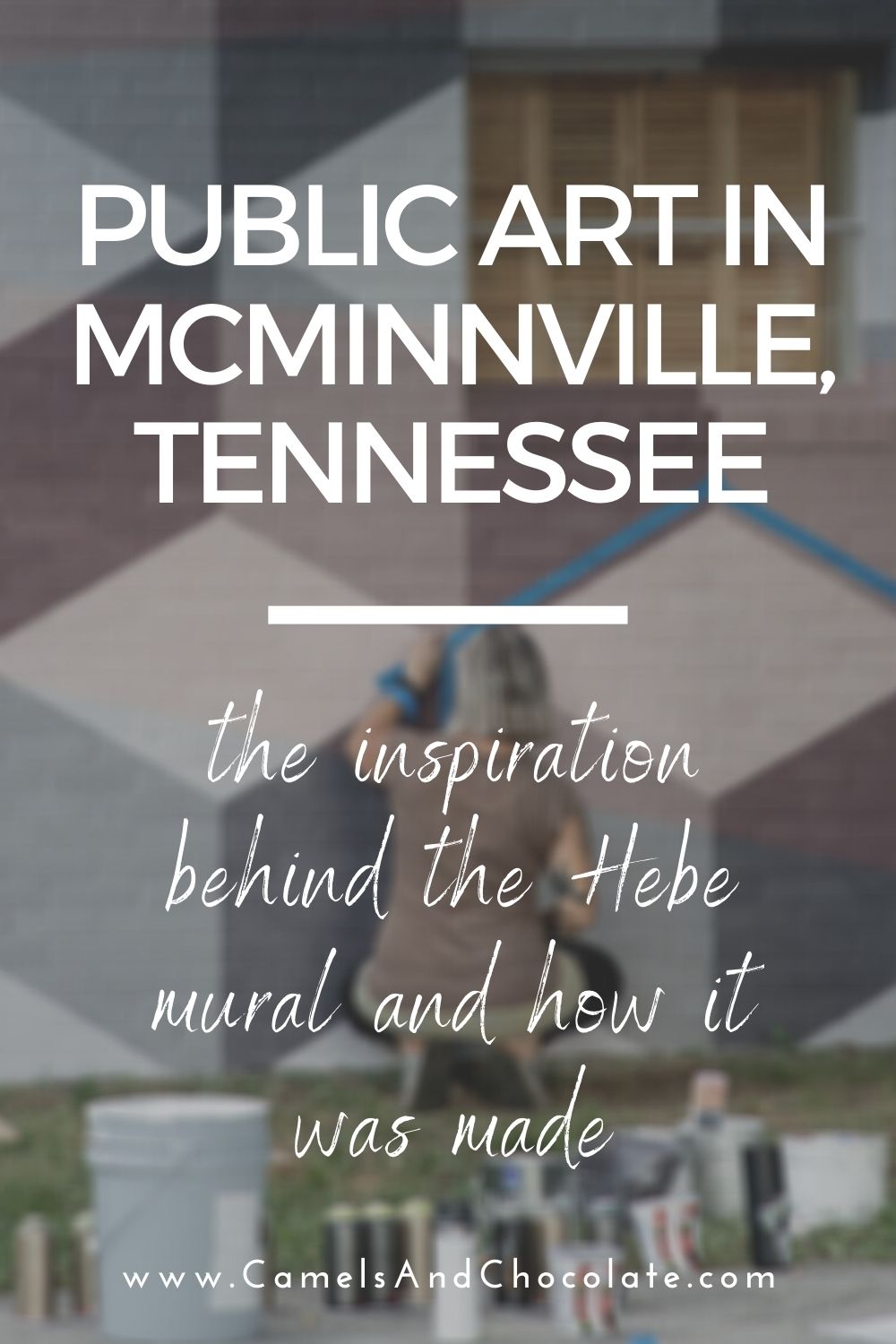
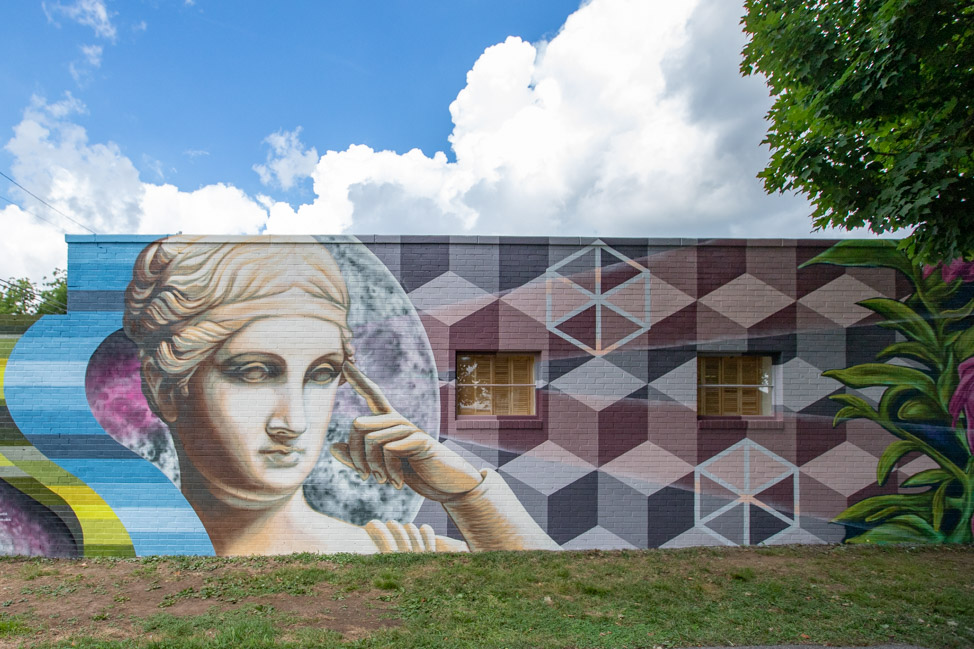
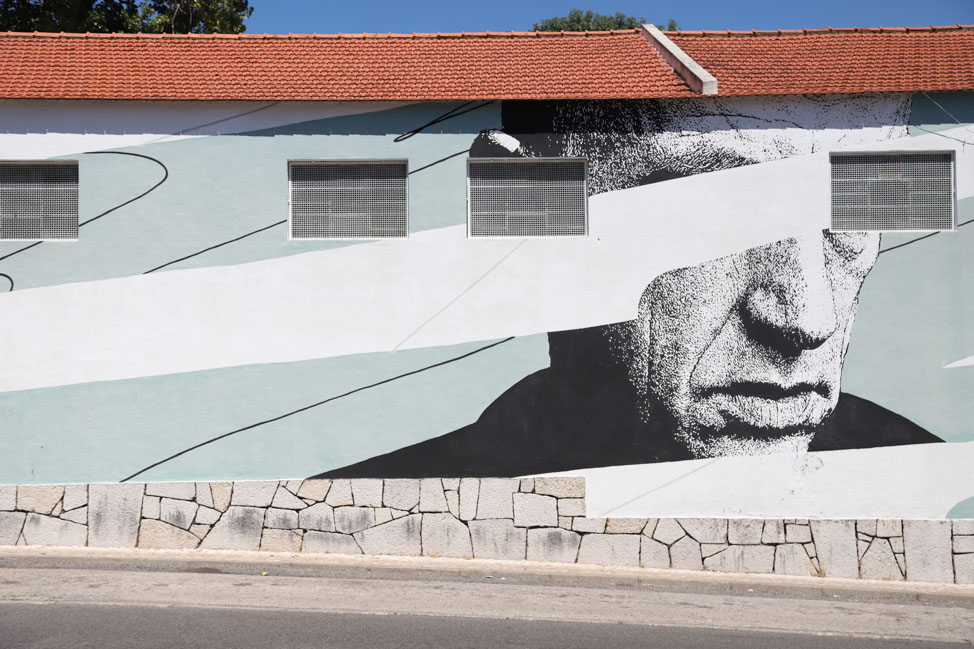
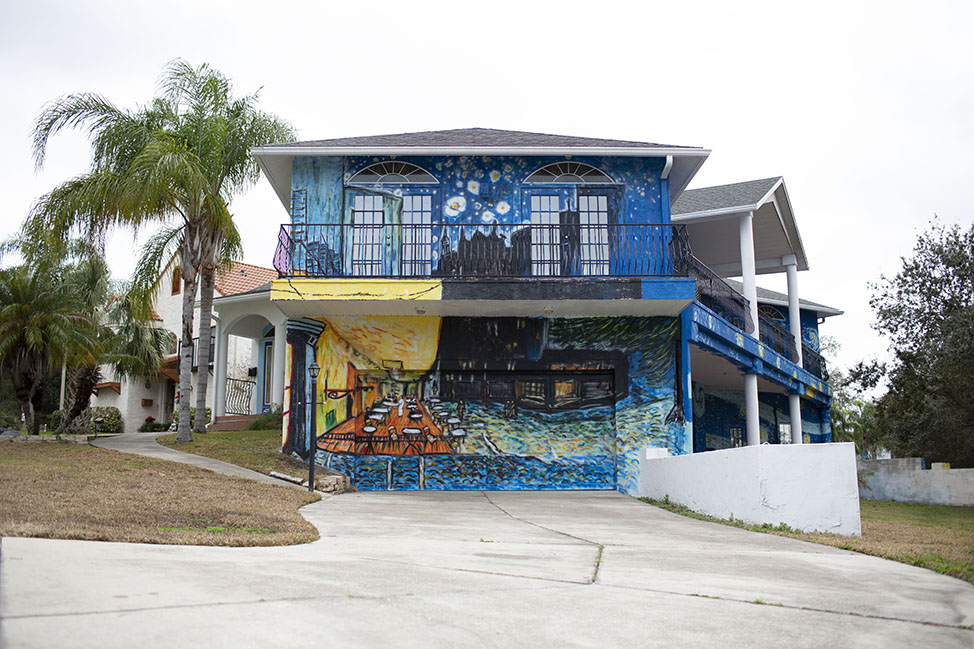
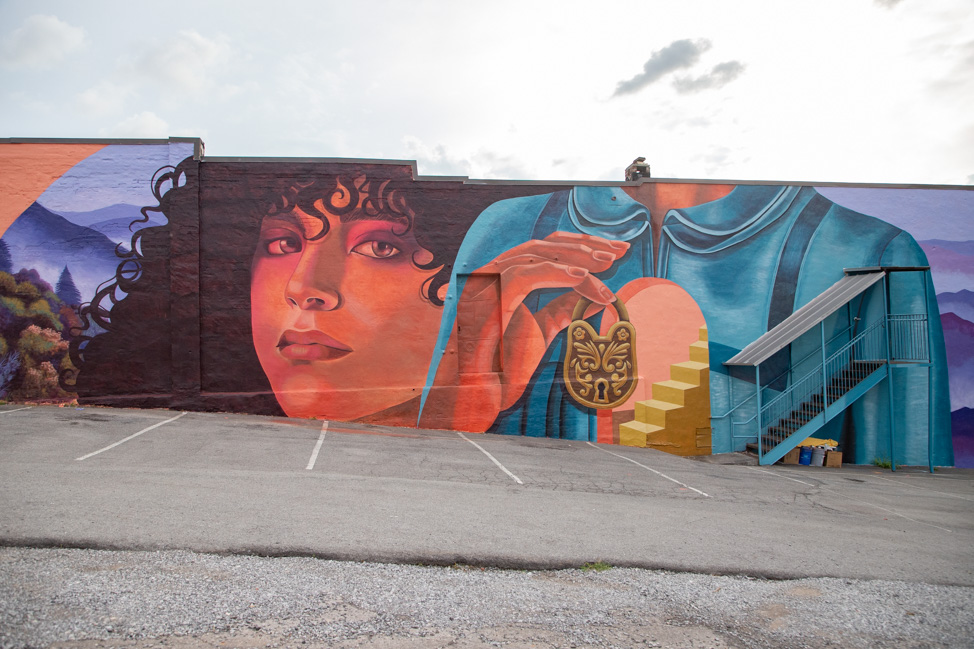
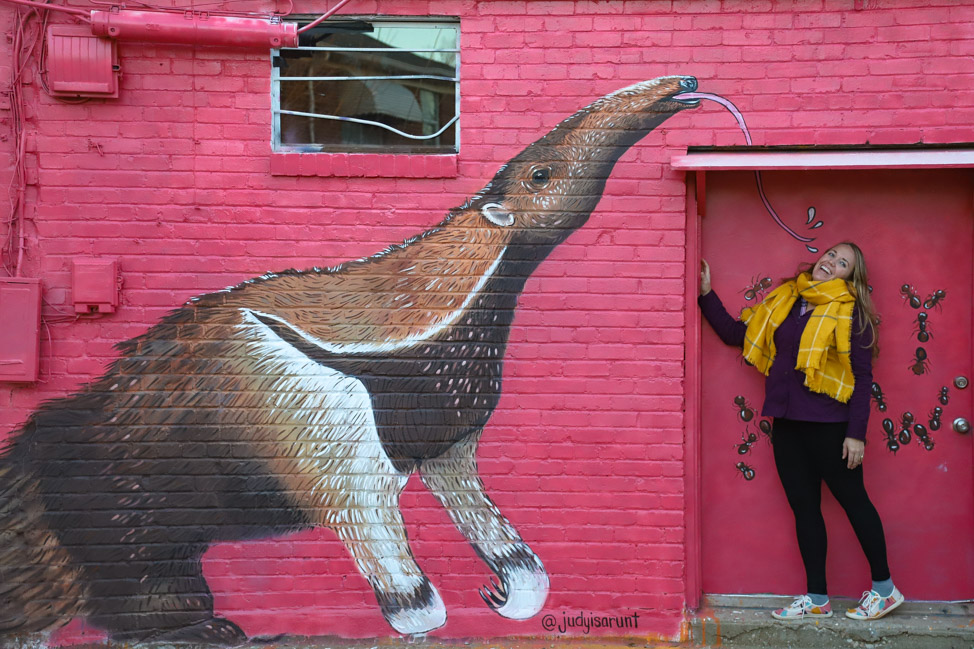
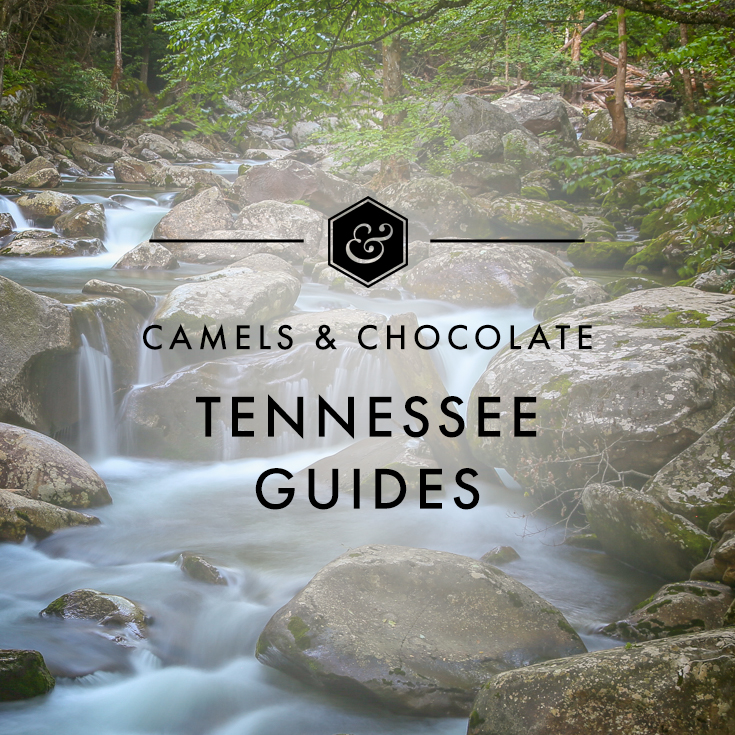









I love the way that you and SVV are helping revive our Tennessee walls and making them beautiful and sending
positive messages.
Your Art Friends have done an amazing job with their
creative talents!!
Awww thank you, Libby! We really love bringing more beauty to rural Tennessee.
Hi. Not sure if this monitored any longer. Jim was my grandfather and I happened upon this article tonight. I have the framed notice that he is holding in the above photos. He was wonderful. I have known his story or is work on Hebe and treasure it greatly, even to the extent of having a tattoo of hebe in his honor. Thank you for these wonderful words. I wish daily he could have seen me become who I am, but I appreciate tremendously that folks have made an attempt to remember him.
I love that you have a Hebe tattoo! That’s so cool. And I’m sure he knows and is proud of you from above 🙂
Loved this article, having grown up here, I’ve loved Hebe since childhood.Hebe once set in the middle of the park before they ruined our park with a street through the middle. I so much appreciate this history on our Hebe. She is a beauty in any form. Also my thanks to the gentleman who spend many of his last days working to restore her. And all who worked many hours with the painting of the mural. When I look at this, I’ll have a lot more respect for all who was involved in Hebe. Love my hometown, McMinnville, TN.
Thank you for your comment, Billie Jo! It truly was a community effort—both the original restoration of the Hebe statue and the mural project from 2020—and we could not have been happier to play a small part in that. Love seeing what downtown McMinnville has become!